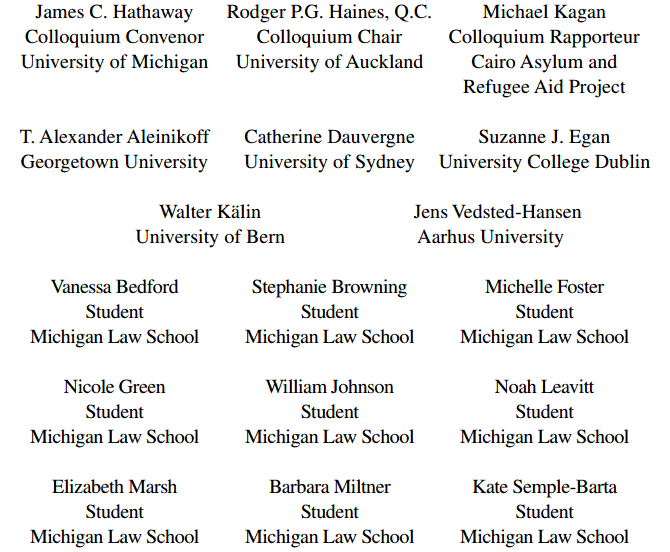The Michigan Guidelines on Nexus to a Convention Ground
THE MICHIGAN GUIDELINES ON NEXUS TO A CONVENTION GROUND
English / French / Russian / Arabic
Introduction
Efforts to promote the contemporary vitality of the Convention refugee definition have usually focussed on refining our understanding of the circumstances in which an individual may be said to be at risk of “being persecuted,” or on giving contemporary relevance to the content of the five grounds upon which risk must be based—race, religion, nationality, membership of a particular social group or political opinion. Comparatively little thought has been given to how best to conceive the causal linkage or nexus between the Convention ground and the risk of being persecuted. In what circumstances may the risk be said to be “for reasons of” one of the five Convention grounds? The jurisprudence of many leading asylum states is simply silent on this issue, while decisions rendered in other states assume that causation in refugee law can be defined by uncritical analogy to standards in other branches of the law. Only rarely have senior courts sought carefully to conceive an understanding of causation of specific relevance to refugee law, including the critical questions of a standard of causation and the types of evidence which should inform the causation inquiry. With a view to promoting a shared understanding of the basic requirements for the recognition of Convention refugee status, we have engaged in sustained collaborative study and reflection on the norms and state practice relevant to the causation inquiry. This research was debated and refined at the Second Colloquium on Challenges in International Refugee Law, convened in March 2001 by the University of Michigan’s Program in Refugee and Asylum Law. These Guidelines are the product of that endeavour, and reflect the consensus of Colloquium participants on how the causal nexus to a Convention ground should be understood in international refugee law.
General Considerations
1. Not every person who is outside his or her own country and has a well-founded fear of being persecuted is a Convention refugee. The risk faced by the applicant must be causally linked to at least one of the five grounds enumerated in the Convention—race, religion, nationality, membership of a particular social group or political opinion. 2. In many states, the requisite causal linkage is explicitly addressed on the basis of the requirement that a refugee’s well-founded fear of being persecuted be “. . . for reasons of race, religion, nationality, membership of a particular social group or political opinion . . .” In other states causation is not treated as a free-standing definitional requirement, but rather is subsumed within the analysis of other Convention requirements. Whether treated as an independent definitional factor or as part of a general understanding of refugee status, the existence of a nexus to a Convention ground must be assessed in the light of the text, context, objects and purposes of the Refugee Convention and Protocol. 3. It is not the duty of the applicant accurately to identify the reason that he or she has a well-founded fear of being persecuted. The state assessing the claim to refugee status shall decide which, if any, Convention ground is relevant to the applicant’s well-founded fear of being persecuted. 4. The risk of being persecuted may sometimes arise in circumstances where two or more Convention grounds combine in the same person, in which case the combination of such grounds defines the causal connection to the wellfounded fear of being persecuted. 5. An individual shall not be expected to deny his or her protected identity or beliefs in order to avoid coming to the attention of the State or non-governmental agent of persecution.
Nature of the Required Causal Link
6. The causal connection required is between a Convention ground and the applicant’s well-founded fear of “being persecuted” (in French, “. . . d’être persécutée . . .”) The focus on the applicant’s predicament follows both from the passive voice employed in the official texts of the Convention and from the Convention’s fundamental purpose of defining the circumstances in which surrogate international protection is warranted. 7. Because it is the applicant’s predicament which must be causally linked to a Convention ground, the fact that his or her subjective fear is based on a Convention ground is insufficient to justify recognition of refugee status. 8. The causal link between the applicant’s predicament and a Convention ground will be revealed by evidence of the reasons which led either to the infliction or threat of a relevant harm, or which cause the applicant’s country of origin to withhold effective protection in the face of a privately inflicted risk. Attribution of the Convention ground to the applicant by the state or non-governmental agent of persecution is sufficient to establish the required causal connection. 9. A causal link may be established whether or not there is evidence of particularized enmity, malignity or animus on the part of the person or group responsible for infliction or threat of a relevant harm, or on the part of a State which withholds its protection from persons at risk of relevant privately inflicted harm. 10. The causal link may also be established in the absence of any evidence of intention to harm or to withhold protection, so long as it is established that the Convention ground contributes to the applicant’s exposure to the risk of being persecuted.
Standard of Causation
11. Standards of causation developed in other branches of international or domestic law ought not to be assumed to have relevance to the recognition of refugee status. Because refugee status determination is both protection-oriented and forward-looking, it is unlikely that pertinent guidance can be gleaned from standards of causation shaped by considerations relevant to the assessment of civil or criminal liability, or which are directed solely to the analysis of past events. 12. The standard of causation must also take account of the practical realities of refugee status determination, in particular the complex combinations of circumstances which may give rise to the risk of being persecuted, the prevalence of evidentiary gaps, and the difficulty of eliciting evidence across linguistic and cultural divides. 13. In view of the unique objects and purposes of refugee status determination, and taking account of the practical challenges of refugee status determination, the Convention ground need not be shown to be the sole, or even the dominant, cause of the risk of being persecuted. It need only be a contributing factor to the risk of being persecuted. If, however, the Convention ground is remote to the point of irrelevance, refugee status need not be recognized.
Evidence of Causation
14. The requisite causal connection between the risk of being persecuted and a Convention ground may be established by either direct or circumstantial evidence. 15. A fear of being persecuted is for reasons of a Convention ground whether it is experienced as an individual, or as part of a group. Thus, evidence that persons who share the applicant’s race, religion, nationality, membership of a particular social group or political opinion are more at risk of being persecuted than others in the home country is a sufficient form of circumstantial evidence that a Convention ground was a contributing factor to the risk of being persecuted. 16. There is, however, no requirement that an applicant for asylum be more at risk than other persons or groups in his or her country of origin. The relevant question is instead whether the Convention ground is causally connected to the applicant’s predicament, irrespective of whether other individuals or groups also face a well-founded fear of being persecuted for the same or a different Convention ground. 17. No special rule governs application of the causal nexus standard in the case of refugees who come from a country in which there is a risk of war or other large-scale violence or oppression. Applicants who come from such a country are not automatically Convention refugees. They are nonetheless entitled to be recognized as refugees if their race, religion, nationality, membership of a particular social group or political opinion is a contributing factor to their well-founded fear of being persecuted in such circumstances. For example, persons in flight from war may be Convention refugees where either the reason for the war or the way in which the war is conducted demonstrates a causal link between a Convention ground and the risk of being persecuted. 18. Refugee status is not restricted to persons who are members of a political, religious or other minority group. While members of minority groups are in practice more commonly exposed to the risk of being persecuted than are persons who are part of majority populations, the only requirement for recognition of refugee status is demonstration that a Convention ground is a contributing factor to the risk of being persecuted. These Guidelines reflect the consensus of all the participants at the Second Colloquium on Challenges in International Refugee Law, held at Ann Arbor, Michigan, USA, on March 23–25, 2001. 
The Colloquium deliberations benefited from the counsel of Mr. Volker Türk Chief, Standards and Legal Advice Section United Nations High Commissioner for Refugees


